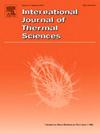用于流动操纵的热驱动微流体旋流器
IF 4.9
2区 工程技术
Q1 ENGINEERING, MECHANICAL
International Journal of Thermal Sciences
Pub Date : 2025-05-12
DOI:10.1016/j.ijthermalsci.2025.109944
引用次数: 0
摘要
在这项工作中,提出了一种原始的热驱动微流体旋流器,用于流动控制应用。旋转机制是热激活的。由于该设备不需要任何移动部件,因此它非常坚固,并且需要极低的维护。旋涡效应是通过激活与气流方向相反的温度梯度来触发的。涡旋机制对应于平流和自然对流在平方截面直微通道内的联合作用。我们在这里提供了一个完整的表征微流体系统从实验和数值的观点。针对旋涡效应对流道雷诺数和水力直径等参数的影响,首次对该装置进行了数值设计和优化。随后,本研究探讨了流动旋流对通道传热机制的影响。结果提出了在广泛的通道尺寸范围内的努塞尔数。在此基础上,研制了物理微流控旋流器样机,并进行了实验表征。用微粒子图像测速仪(μ - PIV)进行了实验,并将实验结果与数值实验结果进行了比较,结果吻合良好。本文章由计算机程序翻译,如有差异,请以英文原文为准。

Thermally-driven microfluidic swirler for flow manipulation
In this work, an original thermally-driven micro-fluidic swirler for flow manipulation applications is proposed. The swirling mechanisms are thermally activated only. Since the device does not require any moving parts, it is robust and needs extremely low maintenance. The swirling effect is triggered by activating a temperature gradient transversely to the stream-wise direction of the flow. The swirling mechanism corresponds to a combined effect of advection and natural convection inside a squared cross-section straight micro-channel. We here offer a complete characterization of the micro-fluidic system both from an experimental and numerical point of view. A first numerical design and optimization of the device was realized in respect to the swirling effect for parameters such as the Reynolds number and hydraulic diameter of the channel. Subsequently, the study explored the impact of the flow swirling on the heat transfer mechanisms along the channel. Results are proposed in terms of the Nusselt number for a wide range of channel dimensions. On these basis, a physical microfluidic swirler prototype was developed and was experimentally characterized. The experiments where performed via micro particle image velocimetry ( – PIV) and velocity fields results were compared to numerical experiments with excellent agreement.
求助全文
通过发布文献求助,成功后即可免费获取论文全文。
去求助
来源期刊

International Journal of Thermal Sciences
工程技术-工程:机械
CiteScore
8.10
自引率
11.10%
发文量
531
审稿时长
55 days
期刊介绍:
The International Journal of Thermal Sciences is a journal devoted to the publication of fundamental studies on the physics of transfer processes in general, with an emphasis on thermal aspects and also applied research on various processes, energy systems and the environment. Articles are published in English and French, and are subject to peer review.
The fundamental subjects considered within the scope of the journal are:
* Heat and relevant mass transfer at all scales (nano, micro and macro) and in all types of material (heterogeneous, composites, biological,...) and fluid flow
* Forced, natural or mixed convection in reactive or non-reactive media
* Single or multi–phase fluid flow with or without phase change
* Near–and far–field radiative heat transfer
* Combined modes of heat transfer in complex systems (for example, plasmas, biological, geological,...)
* Multiscale modelling
The applied research topics include:
* Heat exchangers, heat pipes, cooling processes
* Transport phenomena taking place in industrial processes (chemical, food and agricultural, metallurgical, space and aeronautical, automobile industries)
* Nano–and micro–technology for energy, space, biosystems and devices
* Heat transport analysis in advanced systems
* Impact of energy–related processes on environment, and emerging energy systems
The study of thermophysical properties of materials and fluids, thermal measurement techniques, inverse methods, and the developments of experimental methods are within the scope of the International Journal of Thermal Sciences which also covers the modelling, and numerical methods applied to thermal transfer.
 求助内容:
求助内容: 应助结果提醒方式:
应助结果提醒方式:


